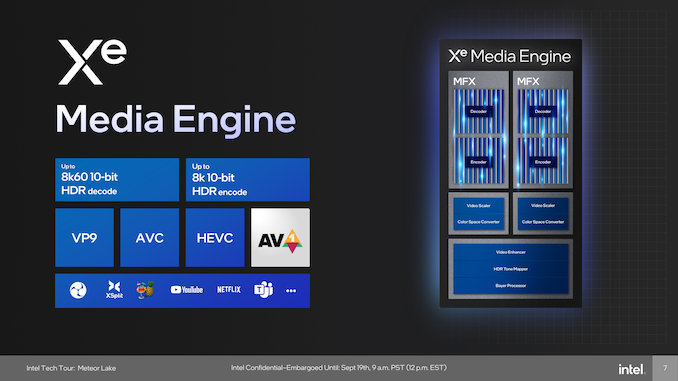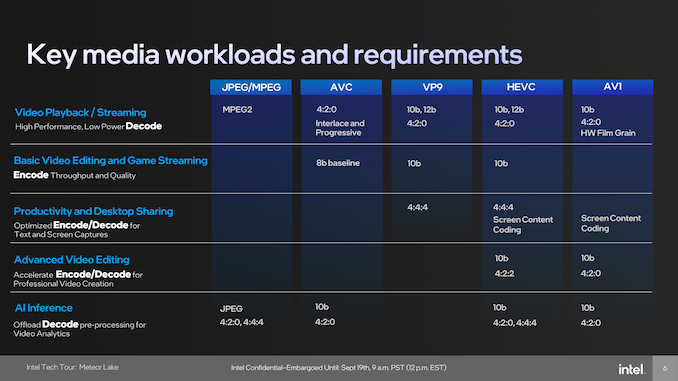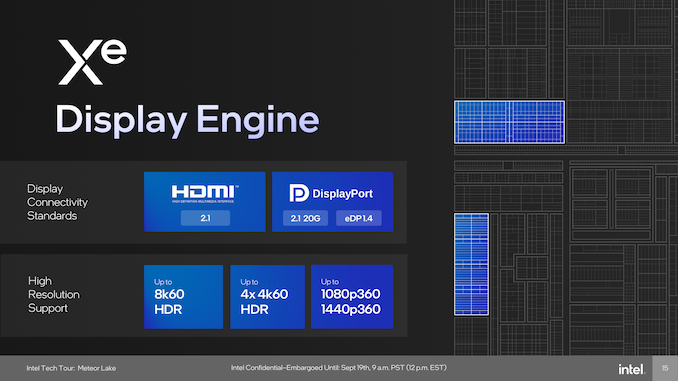Intel Unveils Meteor Lake Architecture: Intel 4 Heralds the Disaggregated Future of Mobile CPUs
by Gavin Bonshor on September 19, 2023 11:35 AM ESTSoC Tile, Part 3: Disaggregating Xe Media and Display Engine From Graphics
As we noted earlier, Intel has completely redesigned its graphics, media, and display engine for Meteor Lake and, as such, separates all three entities from each other. While we'll cover the new graphics tile next, we'll start with everything that's not part of the graphics tile. Opting for a disaggregated architecture allows Intel to not only shuffle things around from an IP perspective but also allows Intel to integrate new IPs such as cores, graphics, and I/O as and when advancements have been made at a silicon level, but the design allows unties Intel from being limited to a specific manufacturing process.
Starting things off, we have the Xe Media Engine, which is embedded within the SoC tile. Within the Xe Media Engine are two Multi-Format Codecs (MFX), designed and responsible for all the encoding and decoding tasks. Intel's Meteor Lake with Xe supports the latest codecs ranging from AV1 (decode and encode), HEVC, AVC, and VP9, with up to 8K60 HDR decode supported. For encoding, there's support for up to 8K resolutions with 10-bit color and HDR. Aiming to improve power efficiency on-chip with encode/decode workloads, having a dedicated Media Engine separate from the graphics allows Intel to find granular power savings as things are directed to the Xe Media Engine, which means the graphics tile doesn't need to be powered up to accomplish encode or decode tasks.
The Xe Media Engine provides various functionalities across a large spectrum of different video codecs. This ranges from JPEG/MPEG and AVC to the more advanced VP9, HEVC, and AV1 codecs. Designed to give Meteor Lake a solid level of computational efficiency for video processing, the Xe Media Engine balances the gaps between high-performance output and power efficiency, rendering it particularly well-suited for various applications, from real-time video streaming to high-fidelity playback. There's also support for diverse color formats and bit depths, including but not limited to 4:2:0 at 10-bit and 12-bit, which means it's versatile for video editing and video encoding and should satisfy content creator's needs.
Xe Display Engine: Also Within the SoC
Much like the Xe Media Engine, the Xe Display Engine is also found within the SoC tile on Meteor Lake. Decoupling this directly from the graphics tile and embedded into the SoC allows it to communicate directly with the Xe Media Engine, saving power and improving overall battery life. The engine supports up to four display pipes, two of which have been designed and optimized for low power consumption, further boosting overall efficiency for Meteor Lake.
Looking at compatibility, the Xe Display Engine looks to use the latest connections and ports, including native support for HDMI 2.1, DisplayPort 2.1, Embedded DisplayPort (eDP) 1.4. and even DSC 1.2a. Via these blocks, Meteor Lake can support displays up to 8K60 HDR, or up to 4 x 4K60 HDR displays, and this is on top of 1080p360 and 1440p360 too. This gives Meteor Lake substantial display and multimedia device support, including current and up-and-coming panels.













107 Comments
View All Comments
Eliadbu - Wednesday, September 20, 2023 - link
The adamantine cache is supposedly at the base tile that all other tiles are connected to.It wasn't mentioned here, maybe if it does exist on MTL we will see information about it when the CPUs will officially come out.
haplo602 - Thursday, September 21, 2023 - link
So now we will have 3 types of cores for the OS to schedule ... I hope Intel is working with OS vendors to properly implement this or it will be a nightmare ... we already saw the 12/13gen issues on Windows 10 and 11 with wrong E to P scheduling ....GeoffreyA - Thursday, September 21, 2023 - link
Complexity is good, says Intel.Vink - Friday, September 22, 2023 - link
Pat Gelsinger does a very good job and I'm speaking concretely because I use series 12 and 13 in the manufacture of Graphics Stations, Ultra PCs, and Standard PCs and they all work PERFECT with maximum benchmark and infinite Tau (only K series)... I'm looking forward to series 14 especially for its benchmark...JayNor - Friday, September 22, 2023 - link
" ...8 x Xe graphics cores with 128 vector engines (12 per Xe core) "16 per xe core
James5mith - Friday, September 29, 2023 - link
"This is because it's the first client processor to be made using chiplets instead of a monolithic design."Don't tell AMD.
dicobalt - Saturday, October 14, 2023 - link
Any indicators of future CAMM sockets integrated directly onto the CPU package?